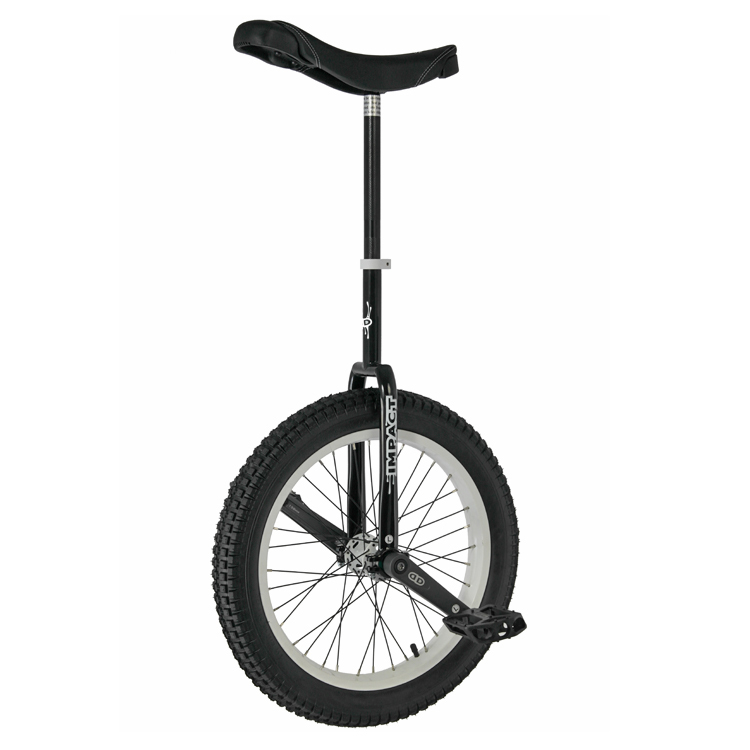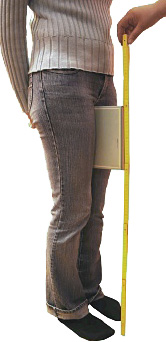WELCOME to all things unicycle!
WELCOME to all things unicycle!
Introduction: Welcome to the fun-filled world of unicycling! To kids young and old, you're about to embark on an adventure that will last a lifetime. The average time needed to learn unicycling is 10-15 hours. That's about an hour a day for two weeks.
Safety Gear: The Unicycle.com team strongly recommends a helmet and wrist guards. We've been unicycling for many years; we all wear safety gear.
Where To Learn: The best place we've found for training is a back deck, preferably made of wood, with a handrail. Wood is more friendly than concrete, and you'll need to hold onto the handrail while your leg muscles learn to react. If you don't have a back deck, try a baseball field with a chain-link fence. Pick a grassy area with solid, flat dirt and you can hold onto the fence.
Does This Thing Have A Front And Back? Yes. The seat post clamp skewer (bolt/nut or quick-release handle) is on the back. The pedal marked "L" should be on your left, "R" on your right.
How High Should The Seat Be? When you're seated on the unicycle, with one foot on a pedal in its lowest position, your leg should be almost straight.



1. Pull the seat into place as shown in the top picture.
2. Spin in the wheel so that the pedal is in the 4:00 position, as shown in the next picture.
3. Put both hands on the handrail or fence, as shown in the third picture.
4. Step on the pedal closest to you. This is different from a bicycle, where you step on the forward pedal. Bicyclists are used to moving forward when mounting. On a unicycle, you want the wheel to rotate 1/4-turn backwards. Step on the pedal and you should now be on the seat with the wheel underneath you.
5. Hold onto the handrail tightly and lean forward slightly while pedaling slowly. Next is the most important tip we can offer you. When the unicycle starts to fall, let it. Stay on your feet and let it fall. The seat can be replaced; your seat can't. Continue to hold onto the handrail until you've practiced steps 1-4 at least three hours.
Congratulations! You're about 10 hours away from riding without assistance! During the next several days you'll ease your grip on the handrail and then hold on with one hand. You'll travel a few feet without assistance, then a few yards, then you'll soon discover the secret to unicycling: Lean in the direction you want to travel and the wheel will try to catch up with you. Always use caution when riding a unicycle. You are responsible for your own safety!







Most adults choose a 20" unicycle to learn on, although a 24" may be better in some instances:
Select the largest unicycle they can ride up to 20".
The table below gives you indicative only. Check in the product descriptions as the size varies by model.
|
Cut down* |
Standard |
|
|
|
50cm (18.5") |
50cm (19.5") |
61.5cm (24") |
|
|
51cm (20") |
60cm (23.5") |
74cm (29") |
|
|
61cm (24") |
71cm (28") |
84cm (33") |
|
|
69cm (27") |
79cm (31") |
93cm (36.6") |
|
|
74cm (29") |
81cm (32") |
92cm (36") |
|
|
74cm (29") |
85cm (33") |
97cm (38") |
|
|
76cm (30") |
86cm (34.5") |
100cm (39") |
|
|
75cm (29.5") |
88cm (34.5") |
97cm (38") |
|
|
81cm (30") |
75cm (29.5") |
103cm (40.5") |
A unicycle seat is directly above the tyre, so when it is pushed down the seatpost will hit the tyre. It is absolutely standard procedure to cut the bottom of the seatpost off to allow the seat height to be lower if required (this will not effect your unicycle's warranty).
This is how to measure the Inseam:
You need to take a book (DVD case) and put it between the persons legs as if they were sitting on a Unicycle ( the same as sitting on a Bicycle seat).Now squeeze the Book between your legs, holding it as tight and as parallel to the ground as possible. Now with a measuring stick / measuring tape, measure from the ground to the upper edge of the book (please measure with shoes):


Here is a breakdown of the sizes and how they can be ridden:
12" Unicycle This is a unicycle designed for a smaller child. It's good for children who are too small to ride a 16" unicycle, but it needs smooth ground and is not really great for most outdoor surfaces. For children up to 5 year olds.
Cut Down Seatpost: 18.5" (47cm) Minimum Leg Length: 19.5" (50cm) Maximum Leg Length: 24" (61.5cm)
16" Unicycle This is a children's unicycle, the small wheel makes it only suitable for very smooth areas. Best used indoors or on smooth ground; it can work outdoors but only on smoother surfaces. Good for learning for 5 to 8 year olds (always check the leg length of your child to be sure)
Cut Down Seatpost: 20"(51cm) Minimum Leg Length: 23.5" (60cm) Maximum Leg Length: 29"(74cm)
20" Unicycle Traditionally the most popular size of unicycle. These are great indoor, they turn quick and the best size for tricks.. They are great for unicycle hockey or basketball. The down side is that they make poor distance machines. Good for learning.
Cut Down Seatpost: 24" (61cm) Minimum Leg Length: 28" (71cm) Maximum Leg Length: 33" (84cm)
24" Unicycle This is a common size among adults for learning. The bigger wheel can be used for freestyle riding but can make some of the advanced freestyle tricks harder. For mountain riding, this wheelsize is better for hopping and jumping and technical single track.
Cut Down Seatpost: 27" (69cm) Minimum Leg Length: 31" (79cm) Maximum Leg Length: 36.6"(93cm)
26" Unicycle This is a versatile size. Great for taller adults to learn on and can be ridden on pavement to off road trails. For mountain riding, this wheelsize is better for less hopping and jumping and more rolling over technical single track.
Cut Down Seatpost: 29" (74cm) Minimum Leg Length: 32" (81cm) Maximum Leg Length: 36" (92cm)
27.5" Unicycle This is the newest wheelsize available and is great for all types of mountain riding. Where this size shines is all the tires that are available in lighter weights and thickness. This is as aggressive as a 24, more agile than a 26.
Cut Down Seatpost: 29" (74cm) Minimum Leg Length: 33" (84cm) Maximum Leg Length: 38" (97cm)
29" Unicycle This is good for commuting and paved paths. For mountain riding this is ideal for fire roads and light single track.
Cut Down Seatpost: 30" (76cm) Minimum Leg Length: 34" (86cm) Maximum Leg Length: 39" (100cm)
32" Unicycle This is good for commuting and paved paths. This wheelsize is faster but agile like the 29" unicycle. For mountain riding this is ideal for fire roads and light single track per the rider's skill level.
Cut Down Seatpost: 30" (76cm) Minimum Leg Length: 33.5" (86cm) Maximum Leg Length: 38" (97cm)
36" Unicycle This is the fastest wheelsize for commuting and paved paths. It can be harder to control because of the weight and diameter of the wheel but the speed you can obtain does offset the handling. For mountain riding this is ideal for fire roads and light single track per the rider's skill level.
Cut Down Seatpost: 30" (81cm) Minimum Leg Length: 29.5" (75cm) Maximum Leg Length: 40.5" (103cm)
Note
These are approximate sizes only, check the website for the model you want. The cut down seatpost measurement is there to show the leg length after you have cut the seatpost shorter. If your legs are longer than the maximum leg length for that size unicycle you can always purchase a longer seat post.